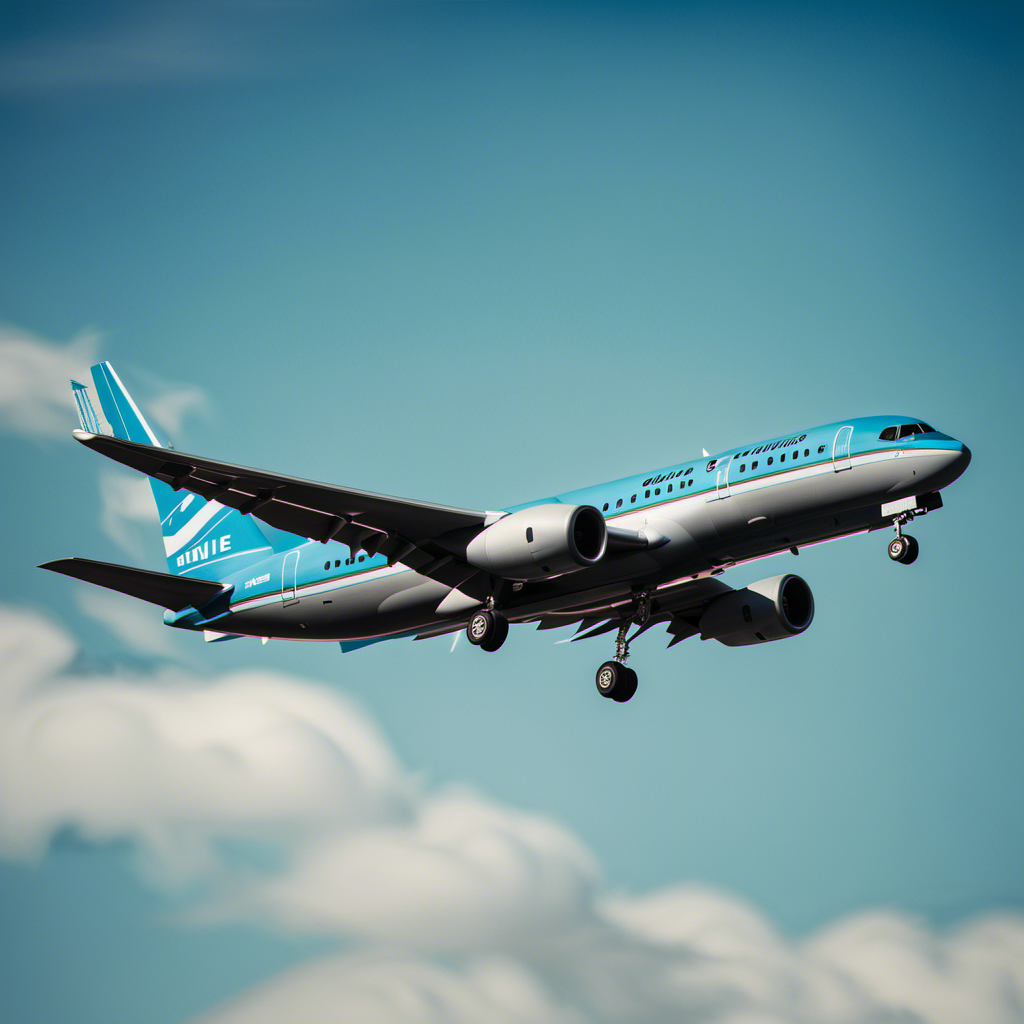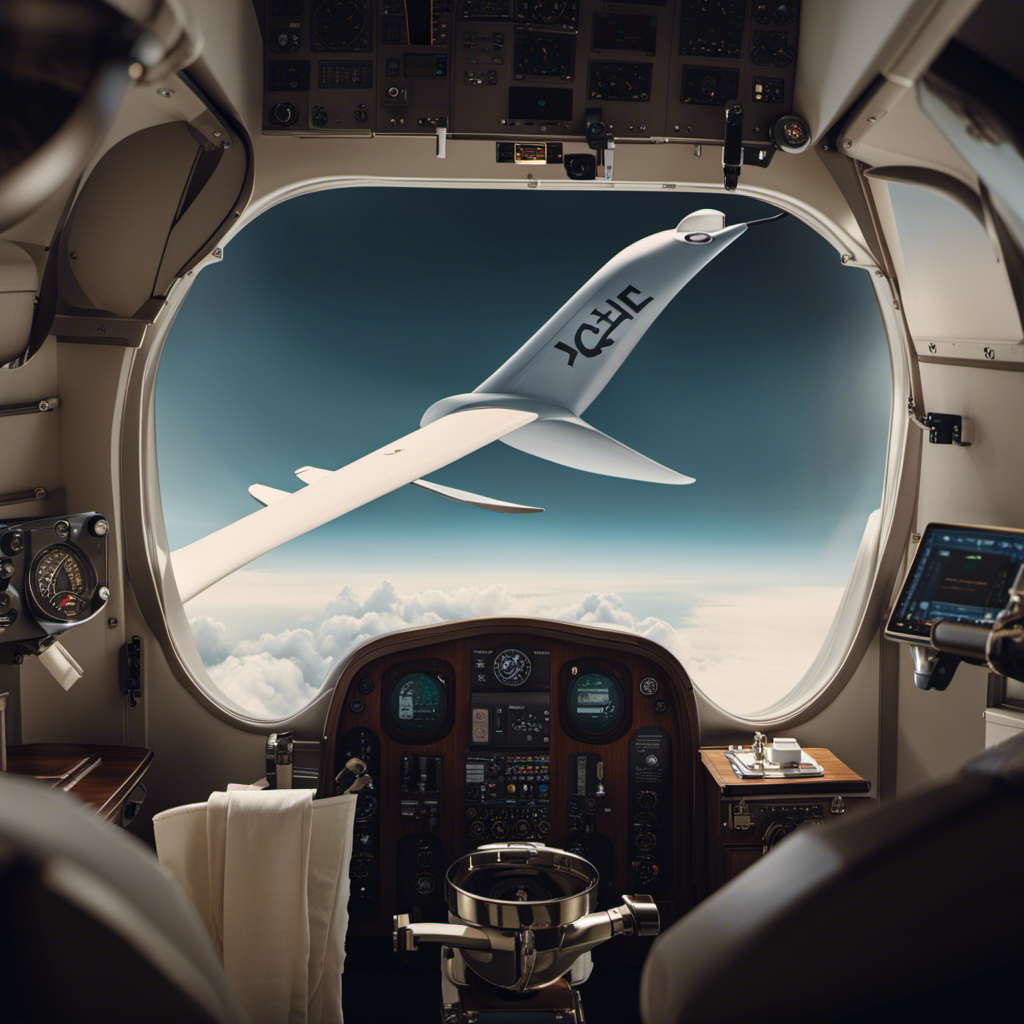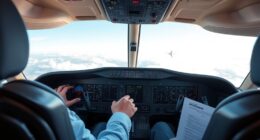As someone passionate about aviation, the magic of flying has always fascinated me.
So, how can an aeroplane fly?
In this article, we’ll delve into the intricate world of aerodynamics and explore the four forces of flight that make soaring through the skies possible.
From the way wings generate lift to the crucial role of engines, we’ll uncover the secrets behind controlling the flight path.
So fasten your seatbelts and prepare for an exhilarating journey into the world of aviation!
Key Takeaways
- Aerodynamics is the study of how air moves around objects and is applied in various industries.
- The four forces of flight include lift, weight, thrust, and drag, which work together to keep an aircraft airborne.
- Wings generate lift through Bernoulli’s Principle, with the shape of the wing and angle of attack playing key roles.
- Engines generate thrust to overcome drag and lift the aircraft, and their design affects performance and fuel consumption.
Introduction to Aerodynamics
Aerodynamics is the study of how air moves around objects, like airplanes. Understanding the principles of aerodynamics is crucial in designing efficient aircraft. It involves analyzing the flow of air over surfaces, the forces acting on the object, and the resulting motion.
By manipulating the shape and design of an aircraft, engineers can optimize its performance and achieve lift, the force that allows planes to take off and stay airborne. The application of aerodynamics extends beyond aviation, with industries such as automotive, civil engineering, and sports benefiting from its principles.
By harnessing the knowledge gained from studying aerodynamics, we can improve the efficiency and performance of various objects and systems.
Now, let’s delve into the four forces of flight that make an airplane soar.
The Four Forces of Flight
To understand how an airplane stays in the air, you need to know about the four forces of flight. These forces, known as lift, weight, thrust, and drag, work together to keep an aircraft airborne.
Here is a brief overview of each force:
-
Lift: This upward force is crucial for flight and is generated by the shape of the wings and the airflow over them.
-
Weight: This force pulls the aircraft downwards and is counteracted by lift.
-
Thrust: This force moves the aircraft forward and is created by the engines.
-
Drag: This force opposes the motion of the aircraft and is caused by air resistance.
Now that we understand the four forces of flight, let’s delve into how wings generate lift.
How Wings Generate Lift
When it comes to understanding how wings generate lift, three key points come to mind: Bernoulli’s Principle, the angle of attack, and airfoil shape.
Bernoulli’s Principle states that as the speed of a fluid increases, its pressure decreases. This principle plays a significant role in lift generation as the airflow over the curved upper surface of an airfoil moves faster than the airflow beneath, resulting in a pressure difference and lift.
The angle of attack refers to the angle between the chord line of an airfoil and the oncoming airflow. By increasing the angle of attack, the lift generated by the wing can be increased.
Lastly, the shape of the airfoil, with its curved upper surface and flatter lower surface, is designed to optimize lift and minimize drag, contributing to efficient flight.
Bernoulli’s Principle
Did you know that Bernoulli’s principle helps explain how an airplane stays airborne? In fluid dynamics, the generation of lift is a crucial aspect of flight.
Bernoulli’s principle states that as the speed of a fluid increases, its pressure decreases. This principle is applied to aircraft wings to create lift. The shape of the wing, called an airfoil, is designed to have a longer distance for air to travel over the top compared to the bottom.
As the airplane moves forward, air flows over the wings, creating a pressure difference. The faster-moving air above the wing creates lower pressure, while the slower-moving air below the wing creates higher pressure. This pressure difference generates lift, allowing the airplane to stay in the air.
Understanding Bernoulli’s principle is just the first step in comprehending the complex physics of flight. Another important factor that contributes to flight is the angle of attack.
Angle of Attack
Understanding the angle of attack is crucial for controlling the lift and stability of an aircraft. Here’s why:
-
Lift generation: The angle of attack determines the amount of lift an aircraft generates. By increasing the angle, more lift can be produced, allowing the aircraft to stay airborne.
-
Balance and stability: The angle of attack plays a vital role in maintaining the balance and stability of an aircraft. It helps control the pitch and prevents the aircraft from stalling or diving uncontrollably.
-
Maneuverability: Adjusting the angle of attack allows pilots to maneuver the aircraft effectively. By changing the angle, they can control the rate of climb, descent, and turn.
-
Aircraft design: The angle of attack also influences the design of the aircraft. Wing shape, airfoil camber, and other aerodynamic features are optimized to achieve the desired angle of attack range for optimal lift and stability.
Transitioning to the next section about ‘airfoil shape,’ it is important to understand how the shape of the airfoil affects the angle of attack and overall aircraft performance.
Airfoil Shape
To optimize lift and stability of your aircraft, it’s crucial to consider the shape of the airfoil. Airfoil design plays a vital role in determining the lift coefficient, which is a measure of the lift generated by the wing at a given angle of attack. The lift coefficient is directly influenced by the shape of the airfoil, particularly its camber and thickness distribution.
In airfoil design, engineers aim to achieve the highest lift coefficient possible while maintaining good stall characteristics and minimizing drag. By carefully shaping the airfoil, they can manipulate the airflow around the wing, creating pressure differences that generate lift. A well-designed airfoil will have a smooth flow of air over the top surface and a controlled separation of airflow at high angles of attack.
To illustrate the impact of airfoil shape on lift coefficient, consider the following table:
| Airfoil Shape | Lift Coefficient |
|---|---|
| Symmetrical | 0.4 |
| Cambered | 1.2 |
| Reflexed | 0.2 |
As we can see, the shape of the airfoil directly affects the lift coefficient, with a cambered airfoil producing the highest lift coefficient.
Understanding the importance of airfoil shape leads us to the next section, where we will explore the role of engines in flight.
Role of Engines in Flight
You might be wondering how engines play a role in the flight of an airplane. Well, engines are essential for generating the necessary thrust to overcome drag and lift the aircraft off the ground. Here’s how they do it:
-
Role of fuel:
-
The engines burn fuel, such as jet fuel or aviation gasoline, to produce energy in the form of thrust.
-
The fuel is stored in onboard tanks and is continuously supplied to the engines during flight.
-
Impact of engine design:
-
Engine design affects the efficiency and power output of an aircraft.
-
Factors like the number of engines, their placement, and the type of propulsion system used can significantly influence an airplane’s performance and fuel consumption.
Engines are just one piece of the puzzle when it comes to aircraft flight. Now, let’s explore how pilots control the flight path without explicitly stating the next section.
Controlling the Flight Path
When it comes to controlling the flight path of an aircraft, three key components play a crucial role: ailerons and roll, elevators and pitch, and rudders and yaw.
Ailerons are located on the wings and are responsible for controlling the aircraft’s roll movement, allowing it to bank left or right.
Elevators, found on the tail of the aircraft, control the pitch and determine whether the nose of the aircraft points up or down.
Lastly, rudders, also located on the tail, control the yaw movement and are responsible for the aircraft’s left or right turning motions.
Ailerons and Roll
Start by understanding how ailerons work to control the roll of the airplane. Ailerons are control surfaces on the wings that move in opposite directions. Their design plays a crucial role in achieving roll stability. Here are four key aspects of aileron design:
-
Differential Ailerons: This design ensures that the upward-moving aileron deflects more than the downward-moving aileron, reducing adverse yaw.
-
Frise Ailerons: These ailerons have a small portion that protrudes into the airflow when deflected downward, creating drag and helping prevent adverse yaw.
-
Horn Balance: Ailerons with horn balance have a weight attached to the aileron’s leading edge, reducing control forces and allowing for smoother control inputs.
-
Flaperons: These are ailerons that also function as flaps, providing both roll control and increased lift during takeoff and landing.
Understanding the intricacies of aileron design is vital for maintaining roll stability in flight.
Now, let’s delve into elevators and pitch control.
Elevators and Pitch
The elevators on an airplane are control surfaces that are used to control the pitch of the aircraft. Elevator control is crucial for adjusting the angle of the airplane’s nose up or down, which directly affects the aircraft’s pitch.
Located on the tail of the airplane, the elevators work in opposition to each other when the pilot operates the control column. By moving the control column forward or backward, the elevator surfaces change their position, causing the aircraft’s nose to pitch up or down accordingly.
This pitch adjustment is essential for maintaining the desired altitude and controlling the aircraft’s speed.
Now, let’s move on to the next section, where we will discuss the rudders and their role in controlling yaw.
Rudders and Yaw
Now let’s see how the rudders come into play and control the aircraft’s yaw.
The rudders are located on the vertical stabilizer at the back of the plane. Their main function is to provide yaw stability, which helps the plane maintain a straight course during flight.
When the pilot applies rudder input, the rudders deflect to either side, creating a force that counteracts the yawing motion. This force is known as rudder effectiveness.
The effectiveness of the rudders depends on various factors such as the speed of the aircraft, the angle of attack, and the position of the center of gravity.
A well-designed rudder system is crucial for maintaining stability and control during flight. Understanding how rudders work is essential for pilots to safely navigate the skies.
In the next section, we will delve into the fascinating world of air pressure and airflow.
Understanding Air Pressure and Airflow
Flying an airplane relies on understanding how air pressure and airflow work. Air pressure, which is the force exerted by the air on a given area, plays a crucial role in flight. As an aircraft moves through the air, the air particles collide with its surface, creating aerodynamic drag. This drag is influenced by the density of the air, which can vary with altitude and temperature.
By manipulating the airflow around the wings and other control surfaces, pilots can generate lift, the force that opposes gravity and allows the airplane to stay airborne. However, understanding air pressure and airflow is just one piece of the puzzle.
Another critical aspect of flying is maintaining the correct weight and balance, which ensures stability and control.
Importance of Weight and Balance
Maintaining the correct weight and balance is crucial for stability and control in an aircraft. The importance of weight distribution and center of gravity analysis cannot be overstated. A well-balanced aircraft ensures that it performs optimally during all phases of flight, from takeoff to landing.
To better understand the significance of weight and balance, let’s take a look at the following table:
| Weight Category | Weight (lbs) |
|---|---|
| Empty Weight | 2,500 |
| Fuel | 800 |
| Passengers | 400 |
| Cargo | 300 |
| Total Weight | 4,000 |
By analyzing the weight distribution, we can determine the aircraft’s center of gravity. This analysis allows us to ensure that the center of gravity remains within safe limits, preventing any potential stability issues.
Now that we have discussed the importance of weight and balance, let’s move on to the next section about flight instruments and navigation systems. These systems play a vital role in ensuring a safe and efficient flight.
Flight Instruments and Navigation Systems
As a pilot, understanding and utilizing flight instruments and navigation systems is crucial for safe and efficient flight.
Three key instruments that play a vital role in this regard are the altimeter and altitude, airspeed indicator, and navigation systems.
The altimeter provides precise information about the aircraft’s vertical position above sea level, allowing for accurate altitude control and compliance with airspace regulations.
The airspeed indicator, on the other hand, measures the speed at which the aircraft is moving through the air, enabling pilots to maintain desired speeds for various flight phases.
Lastly, navigation systems provide pilots with real-time information on their position and route, aiding in navigation, flight planning, and avoiding potential hazards.
Altimeter and Altitude
To understand how an airplane maintains altitude, you need to familiarize yourself with the altimeter. The altimeter is a flight instrument that measures the aircraft’s altitude above a given reference point, usually mean sea level. It does this by using atmospheric pressure as a reference. The altimeter must be calibrated regularly to ensure accuracy.
As the aircraft climbs or descends, the altimeter adjusts the altitude reading based on the changing atmospheric pressure. It is crucial to understand the effects of altitude on the human body. As the altitude increases, the air becomes thinner, which can lead to decreased oxygen levels. This can cause symptoms such as dizziness, fatigue, and even hypoxia. Understanding these effects is essential for pilots to ensure the safety and well-being of themselves and their passengers.
Transitioning to the next section, the airspeed indicator provides crucial information about the aircraft’s speed.
Airspeed Indicator
After understanding how altitude is measured, let’s focus on another crucial instrument in an airplane – the airspeed indicator. This instrument provides information about the aircraft’s speed through the air. It is vital for pilots to know their airspeed to maintain safe flight operations and to ensure optimal performance.
The airspeed indicator measures the dynamic pressure of the air using a pitot tube, which is mounted on the aircraft’s exterior. As the aircraft moves through the air, the pitot tube captures the pressure and converts it into airspeed measurements.
Here are four important points about airspeed measurement:
- The airspeed indicator provides information in knots, which is the standard unit of measurement for airspeed.
- The indicated airspeed (IAS) is the reading directly obtained from the airspeed indicator.
- The true airspeed (TAS) is the actual speed of the aircraft through the air and is calculated by correcting the IAS for altitude and temperature.
- The calibrated airspeed (CAS) is the IAS corrected for instrument and position errors.
Understanding the airspeed indicator is essential for pilots to make informed decisions during flight. Now, let’s delve into the next section on navigation systems.
Navigation Systems
When navigating, you can rely on various systems such as GPS and inertial navigation systems to determine your position and course. The use of GPS technology has revolutionized aviation, providing accurate and reliable positioning information.
GPS satellites transmit signals that are received by the aircraft’s onboard GPS receiver, allowing it to calculate the aircraft’s position with remarkable precision. This enables pilots to navigate with confidence, even in challenging weather conditions or unfamiliar areas. However, it’s important to note that GPS can be affected by factors such as signal blockage or interference.
Therefore, it’s essential for pilots to have backup navigation systems, such as inertial navigation systems or the reliable magnetic compass, which can provide accurate heading information. These navigation systems, together with the pilot’s skill and knowledge, ensure safe and efficient flight operations.
Moving on to factors affecting flight performance…
Factors Affecting Flight Performance
You should consider the factors that affect flight performance when trying to understand how an aeroplane can fly. Two important factors are the factors affecting fuel efficiency and the impact of weather on flight performance.
Fuel efficiency is influenced by various factors such as aircraft weight, altitude, and speed. A lighter aircraft requires less fuel to fly, while flying at higher altitudes and lower speeds can also improve fuel efficiency.
On the other hand, weather conditions can significantly impact flight performance. Strong winds can affect the aircraft’s speed and stability, while turbulent weather can make the flight uncomfortable for passengers and crew.
These factors are crucial in determining the overall performance and efficiency of an aircraft during flight. Considering these factors is vital for a safe and efficient flight.
Looking ahead, advancements in technology will continue to shape the future of aviation, enabling even greater efficiency and safety in flight operations.
Conclusion and Future Developments in Aviation
To conclude, advancements in technology will shape the future of aviation, allowing for even greater efficiency and safety in flight operations.
The continuous development of aircraft systems, materials, and propulsion technologies will lead to significant improvements in aircraft performance.
Future advancements in aviation will focus on reducing fuel consumption and emissions, thereby minimizing the impact on the environment.
The introduction of more fuel-efficient engines, lightweight materials, and advanced aerodynamic designs will contribute to the overall sustainability of air travel.
Additionally, the integration of advanced navigation and communication systems will enhance the safety and efficiency of flight operations.
As we move forward, it’s crucial to prioritize sustainable solutions that not only improve the efficiency of aviation but also minimize its environmental footprint.
Frequently Asked Questions
What are the different types of engines used in airplanes?
There are two main types of engines used in airplanes: jet engines and propeller engines. Jet engines work by compressing air and mixing it with fuel, while propeller engines use rotating blades to generate thrust. Both engines enable airplanes to fly.
How do pilots navigate during a flight?
During a flight, pilots navigate using a combination of instruments and pilot communication with air traffic control. They follow specific air traffic control procedures, which include receiving clearances, following designated routes, and communicating their position and intentions to ensure safe and efficient travel.
What are the main flight instruments used by pilots?
As a pilot, I rely on a set of flight instruments to navigate during a flight. These instruments, such as the altimeter, airspeed indicator, and compass, provide precise and essential information for safe and efficient pilot navigation.
How does the weight and balance of an airplane affect its flight performance?
The weight distribution and center of gravity of an airplane significantly impact its flight performance. Proper weight distribution ensures stability and maneuverability, while the center of gravity affects the aircraft’s balance and control.
What are some future developments in aviation that may impact the way airplanes fly?
Electric propulsion and hypersonic travel are two future developments in aviation that will significantly impact the way airplanes fly. These advancements will revolutionize the speed, efficiency, and overall performance of aircraft, ushering in a new era of aviation.
Conclusion
In conclusion, understanding the principles of aerodynamics is crucial in comprehending how an airplane can fly. The four forces of flight, namely lift, weight, thrust, and drag, play a vital role in the aircraft’s ability to stay airborne.
Interestingly, did you know that the average commercial airliner weighs around 400,000 pounds? This astonishing statistic highlights the remarkable engineering and design required to keep such a massive object soaring through the skies.
As aviation continues to advance, future developments promise even more incredible feats in the world of flight.
With a heart that soars as high as the skies, Aria, affectionately known as “Skylark,” is the driving force behind Soaring Skyways. Her journey into the gliding world began as a young dreamer gazing up at the soaring birds, yearning to experience the weightlessness and freedom they embodied. With years of experience both in the cockpit and behind the scenes, Aria’s commitment to the gliding community is unwavering.










